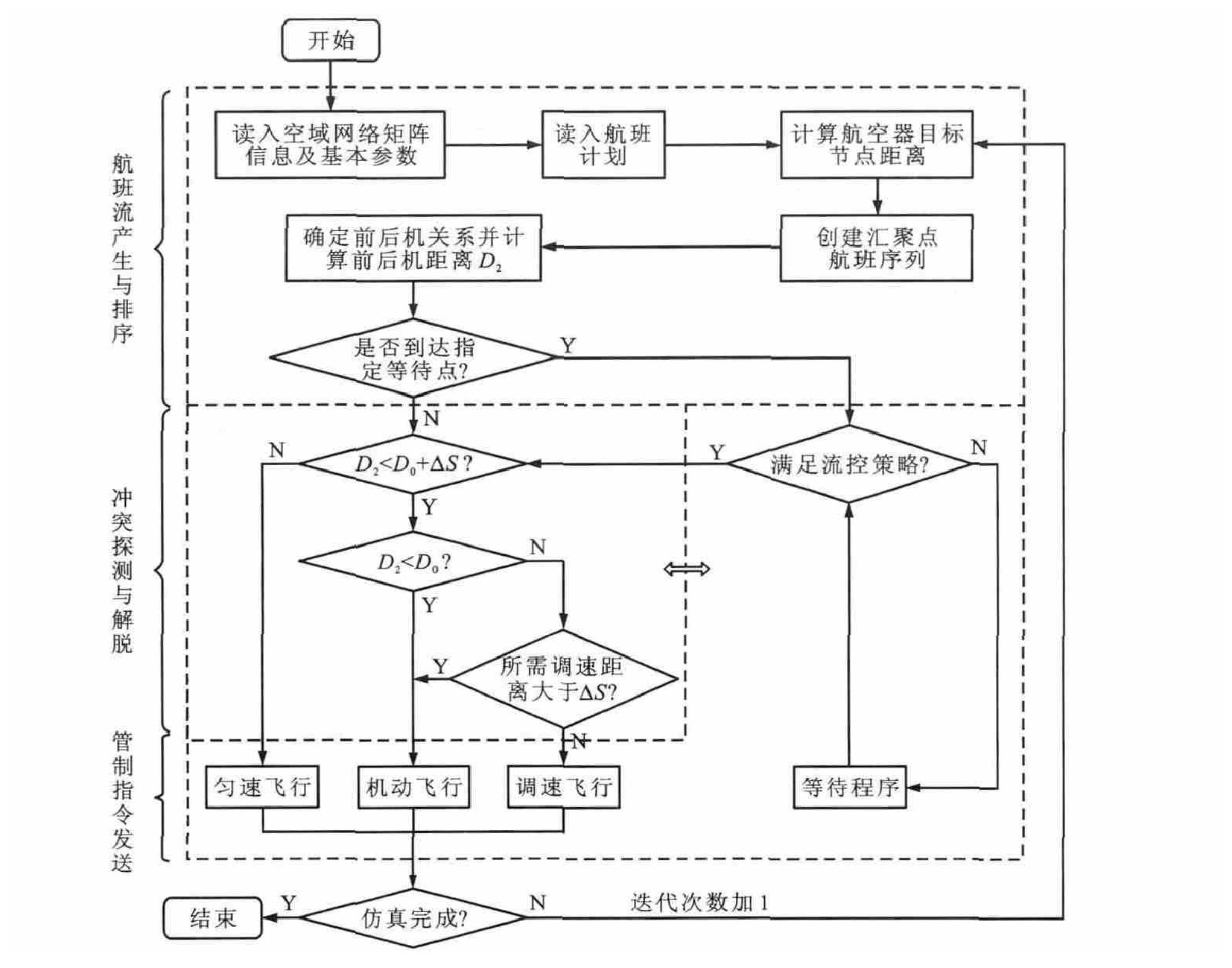-
摘要: 根据终端区空域运行规则, 采用网络理论建立了终端区空域网络模型, 基于终端区航空器微观行为建立了空中交通流跟驰模型和等待模型, 基于NetLogo仿真平台进行了仿真试验, 分析了不同入度分布的空域结构对交通流的影响。仿真结果表明: 当密度小于等于0.075架次·km-1, 速度大于等于0.04 km·s-1时, 交通流处于自由相; 当密度为0.075~0.200架次·km-1且速度大于等于0.04 km·s-1时, 交通流处于畅行相; 当密度大于0.200架次·km-1, 小于最大密度时, 交通流处于拥塞相; 随着航班波作用的减弱, 交通流进入反向畅行相, 之后进入反向自由相; 当进场交通流分布一定, 入度值依次为2、3、1时, 交通流速度小, 密度大, 拥塞消散最慢, 入度值依次为3、2、1时, 交通流速度大, 密度小, 拥塞消散最快。可知, 增大空域网络上游关键节点的入度, 使进场交通流提前完成汇聚, 有利于交通流快速运行, 增大交通流量; 减小空域网络下游关键节点的入度, 有利于交通流在达到拥塞相后快速完成消散。Abstract: The airspace network model in terminal area was built according to the airspace operation rules in terminal area by the network theory.Air traffic flow following model and holding model were built based on aircraft microcosmic behaviors.Simulation test was carried out based on NetLogo simulation platform.The impact of airspace structures with different in-degree distributions on traffic flow was analyzed.Simulation result shows that when the density is less than or equal to 0.075 flight per km and the velocity is more than or equal to 0.04 km·s-1, the traffic flow is in free phase.When the density is 0.075-0.200 flight per km and the velocity is more than or equal to 0.04 km·s-1, the traffic flow is in unblocked phase.When the density is more than 0.200 flight per km and less than the maximal density, the traffic flow is in congestion phase.With the decrease of flight wave function, the traffic flow enters inverse unblocked phase, then inverse free phase.Under the condition that the arrival traffic flow distribution is fixed, when the in-degree value is 2, 3, 1 successively, the velocity of traffic flow is small, the density is big, and the congestion dissipates slowest.When the in-degree value is 3, 2, 1 successively, the velocity of traffic flow is big, the density is small, and the congestion dissipates quickest.Itis known that increasing key node in-degree of up-stream in airspace network can make arrival traffic flow converge ahead of time, make traffic flow operate faster and increase traffic flow rate.Decreasing key node in-degree of down-stream in airspace network is benefit to congestion dissipating quickly after traffic flow entering congestion phase.
-
Key words:
- air transportation /
- air traffic flow /
- airspace structure /
- following model /
- traffic flow phase /
- terminal area
-
表 1 空域结构关键节点的入度
Table 1. In-degrees of key nodes in airspace structures

-
[1] CLARKE J P B, SOLAK S, REN Li-ling, et al. Determining stochastic airspace capacity for air traffic flow management[J]. Transportation Science, 2013, 47(4): 542-559. doi: 10.1287/trsc.1120.0440 [2] JANIC M. Modelling the capacity of closely-spaced parallel runways using innovative approach procedures[J]. Transportation Research Part C: Emerging Technologies, 2008, 16(6): 704-730. doi: 10.1016/j.trc.2008.01.003 [3] DELL'OLMO P, LULLI G. A dynamic programming approach for the airport capacity allocation problem[J]. IMA Journal of Management Mathematics, 2003, 14(3): 235-249. doi: 10.1093/imaman/14.3.235 [4] ROMANO E, SANTILLO L C, ZOPPOLI P. A static algorithm to solve the air traffic sequencing problem[J]. WSEAS Transactions on Systems, 2008, 7(6): 682-695. [5] NIKOLERIS T, HANSEN M. Queueing models for trajectorybased aircraft operations[J]. Transportation Science, 2012, 46(4): 501-511. doi: 10.1287/trsc.1120.0411 [6] MIHETEC T, STEINER S, ODIĆ D. Utilization of flexible airspace structure in flight efficiency optimization[J]. PROMETTraffic and Transportation, 2013, 25(2): 109-118. [7] KULKARNI S, GANESAN R, SHERRY L. Dynamic airspace configuration using approximate dynamic programming: intelligence-based paradigm[J]. Transportation Research Record, 2012(2266): 31-37. [8] SAVAI M P, LI Jin-hua, WANG Tong, et al. An algorithm for adaptable dynamic airspace configuration[C]//AIAA. 10th AIAA Aviation Technology, Integration, and Operations(ATIO)Conference. Reston: AIAA, 2010: 1-10. [9] TANG Jiang-jun, ALAM S, LOKAN C, et al. A multiobjective approach for dynamic airspace sectorization using agent based and geometric models[J]. Transportation Research Part C: Emerging Technologies, 2012, 21(1): 89-121. doi: 10.1016/j.trc.2011.08.008 [10] DE ALBUQUERQUE FILHO E A F. Analysis of airspace traffic structure and air traffic control techniques[D]. Cambridge: Massachusetts Institute of Technology, 2012. [11] 张明, 韩松臣. 基于空域灵活使用的终端空域规划设计方法[J]. 交通信息与安全, 2013, 31(5): 5-9. https://www.cnki.com.cn/Article/CJFDTOTAL-JTJS201305002.htmZHANG Ming, HAN Song-chen. Method of terminal airspace planning based on flexible use of airspace[J]. Journal of Transport Information and Safety, 2013, 31(5): 5-9. (in Chinese) https://www.cnki.com.cn/Article/CJFDTOTAL-JTJS201305002.htm [12] 孙晓阳, 胡明华, 张洪海. 空域和流量协同管理建模与仿真[J]. 交通运输工程学报, 2010, 10(1): 72-76. https://www.cnki.com.cn/Article/CJFDTOTAL-JYGC201001016.htmSUN Xiao-yang, HU Ming-hua, ZHANG Hong-hai. Modeling and simulation of collaborative management for airspace and traffic flow[J]. Journal of Traffic and Transportation Engineering, 2010, 10(1): 72-76. (in Chinese) https://www.cnki.com.cn/Article/CJFDTOTAL-JYGC201001016.htm [13] 陈星. 动态空域飞行流量自适应调配技术[D]. 南京: 南京航空航天大学, 2009.CHEN Xing. Auto-adapted adjusting technology of flight flow in the dynamic airspace[D]. Nanjing: Nanjing University of Aeronautics and Astronautics, 2009. (in Chinese) [14] 陈欣, 陆迅, 朱金福. 枢纽机场空侧容量利用和流量分配优化模型[J]. 南京航空航天大学学报, 2007, 39(5): 680-684. doi: 10.3969/j.issn.1005-2615.2007.05.026CHEN Xin, LU Xun, ZHU Jin-fu. Optimization model of hub-airport airside capacity utilization and flow allocation[J]. Journal of Nanjing University of Aeronautics and Astronautics, 2007, 39(5): 680-684. (in Chinese) doi: 10.3969/j.issn.1005-2615.2007.05.026 [15] 刘强, 白存儒, 林键, 等. 空中交通流线性二次型最优控制[J]. 交通与计算机, 2008, 26(6): 116-119. https://www.cnki.com.cn/Article/CJFDTOTAL-JTJS200806033.htmLIU Qiang, BAI Cun-ru, LIN Jian, et al. Linear-quadratic optimal control of air traffic flow[J]. Computer and Communications, 2008, 26(6): 116-119. (in Chinese) https://www.cnki.com.cn/Article/CJFDTOTAL-JTJS200806033.htm [16] 程朋, 崔德光, 吴澄. 空中交通短期流量管理的动态网络流模型[J]. 清华大学学报: 自然科学版, 2000, 40(11): 114-118. https://www.cnki.com.cn/Article/CJFDTOTAL-QHXB200011029.htmCHENG Peng, CUI De-guang, WU Cheng. Dynamic network flow model for short-term air traffic flow management[J]. Journal of Tsinghua University: Science and Technology, 2000, 40(11): 114-118. (in Chinese) https://www.cnki.com.cn/Article/CJFDTOTAL-QHXB200011029.htm [17] MENON P K, SWERIDUK G D, BILIMORIA K D. New approach for modeling, analysis and control of air traffic flow[J]. Journal of Guidance, Control, and Dynamics, 2004, 27(5): 737-744. doi: 10.2514/1.2556 [18] BAYEN A M, RAFFARD R L, TOMLIN C J. Adjoint-based control of a new Eulerian network model of air traffic flow[J]. IEEE Transactions on Control Systems Technology, 2006, 14(5): 804-818. doi: 10.1109/TCST.2006.876904 [19] SUN Deng-feng, STRUB I S, BAYEN A M. Comparison of the performance of four Eulerian network flow models for strategic air traffic management[J]. Networks and Heterogeneous Media, 2007, 2(4): 569-595. [20] 王莉莉, 张新瑜, 张兆宁. 空中高速路交通流的跟驰现象及流量模型[J]. 西南交通大学学报, 2012, 47(1): 158-162. https://www.cnki.com.cn/Article/CJFDTOTAL-XNJT201201029.htmWANG Li-li, ZHANG Xin-yu, ZHANG Zhao-ning. Following phenomenon and air freeway flow model[J]. Journal of Southwest Jiaotong University, 2012, 47(1): 158-162. (in Chinese) https://www.cnki.com.cn/Article/CJFDTOTAL-XNJT201201029.htm [21] 张洪海, 杨磊, 别翌荟, 等. 终端区进场交通流广义跟驰行为与复杂相变分析[J]. 航空学报, 2015, 36(3): 949-961. https://www.cnki.com.cn/Article/CJFDTOTAL-HKXB201503029.htmZHANG Hong-hai, YANG Lei, BIE Yi-hui, et al. Analysis on generalized following behavior and complex phase-transition law of approaching traffic flow in terminal airspace[J]. Acta Aeronautica et Astronautica Sinica, 2015, 36(3): 949-961. (in Chinese) https://www.cnki.com.cn/Article/CJFDTOTAL-HKXB201503029.htm [22] ZHANG Hong-hai, XU Yan, YANG Lei, et al. Macroscopic model and simulation analysis of air traffic flow in airport terminal area[J]. Discrete Dynamics in Nature and Society, 2014, 2014: 1-15. [23] 张洪海, 许炎, 张哲铭, 等. 终端区空中交通流参数模型与仿真[J]. 交通运输系统工程与信息, 2014, 14(6): 58-64. https://www.cnki.com.cn/Article/CJFDTOTAL-YSXT201406009.htmZHANG Hong-hai, XU Yan, ZHANG Zhe-ming, et al. Air traffic flow parameter model and simulation for airport terminal area[J]. Journal of Transportation Systems Engineering and Information Technology, 2014, 14(6): 58-64. (in Chinese) https://www.cnki.com.cn/Article/CJFDTOTAL-YSXT201406009.htm [24] 张洪海, 廖志华, 祝前进. 基于CTM的终端区交通流参数关系研究[J]. 航空计算技术, 2014, 44(4): 1-5, 9. https://www.cnki.com.cn/Article/CJFDTOTAL-HKJJ201404001.htmZHANG Hong-hai, LIAO Zhi-hua, ZHU Qian-jin. Research on relationships among terminal traffic flow parameters based on CTM[J]. Aeronautical Computing Technique, 2014, 44(4): 1-5, 9. (in Chinese) https://www.cnki.com.cn/Article/CJFDTOTAL-HKJJ201404001.htm [25] 许炎, 张洪海, 杨磊, 等. 基于实测数据的终端区空中交通流特性分析[J]. 交通运输系统工程与信息, 2015, 15(1): 205-211. https://www.cnki.com.cn/Article/CJFDTOTAL-YSXT201501034.htmXU Yan, ZHANG Hong-hai, YANG Lei, et al. Analysis of air traffic flow characteristics in airport terminal area based on observed data[J]. Journal of Transportation Systems Engineering and Information Technology, 2015, 15(1): 205-211. (in Chinese) https://www.cnki.com.cn/Article/CJFDTOTAL-YSXT201501034.htm -





 下载:
下载:







